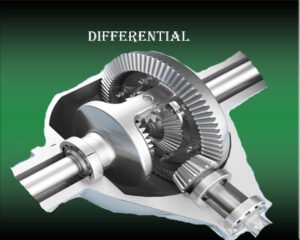
A differential is a mechanical system present on all vehicles. In particular, it allows the drive wheels to turn at different speeds to facilitate a turn, for example. Integrated into the gearbox, the differential is made up of three conical pinions and a ring gear which drives the entire device. The differential performs three main roles:
It maintains your vehicle’s traction by allowing different speeds between the wheels; It provides better road holding, as without a differential the vehicle would tend to go straight; It limits the wear of your tyres.
The use of a differential is more widespread in the automotive sector but it is also found in the field of watchmaking. The system can then have several functions such as, for example, that of compensating for the differences between two balance wheels fitted to certain watches.
How does an automotive differential work?
The differential is mainly used when cornering. When you turn your steering wheel, the drive wheels of your vehicle will also turn. However, the distance that each of the two wheels will travel is not the same.
For example, if you are taking a right turn, the right front wheel located on the inside of the turn needs a lower rotational speed than the left wheel since it travels a shorter distance. Concretely, the right wheel being slowed down, only the left wheel is driven by the central pinion and then begins to accelerate.
The differential isn’t just for cornering, it also allows for different rotational speeds in other situations: between the front and rear axle for example, especially on 4WD off-road cars with transmission integral where the power must be distributed over four wheels instead of two as on traction vehicles.
What are the limits of the differential on a car?
The differential mechanism works perfectly under “classic” conditions, but it has one major drawback: it transfers the same rotational effort (also called torque) in the same direction to both sides. This means that it is ultimately the wheel with the least grip that benefits from the most power.
However, in some cases it would be preferable to be able to provide greater torque to the wheel which has the best grip.Imagine instead: if one of your wheels loses grip (by slipping on an icy patch for example), all the power is transmitted to this wheel, while the other wheel with better grip has none. Powerful.
The wheel on ice slips and you lose traction, which increases the risk of an accident.
What is the point of a limited slip differential?
The limited-slip differential, also called self-locking, has the task of limiting the difference between the rotational speeds of the right and left wheels (or between the front and rear axle on an all-wheel drive).
Unlike the differential lock, which consists of locking the system so that the torque is always identical between the left and right wheels, the self-locking differential does not cause the wheels to join together.
There are two types of self-locking differentials: mechanical and electronic. The mechanical system exists in different forms. Here are the main limited slip differentials you can find on the market:
Electronics: The ESP (Electronic Stability Program) system brakes a wheel when overspeed is detected using specific sensors located on the wheel;
Torsen: This is a 100% mechanical device. It is the best known and most appreciated by mechanical enthusiasts. A permanent and physical link is created between two sprockets which makes it impossible for a large difference in speed between two wheels;
Crown-Gear: Again, this is a 100% mechanical system. The idea is the same as with the Torsen only the maximum torque that is sent backwards is different from that sent forward;
The viscous coupling: The system is bathed in a specific oil mixed with silicone, when there is a significant difference in rotation, the friction of the clutches heats the oil which expands and increases the link between the clutch discs , which reduces slippage;
Piloted multi-disc clutches: The device is mechanical but it is electronically controlled by a hydraulic system. Unlike the viscous coupling, it is not the heating of the oil that causes the differential to lock.
Even if it is little appreciated by mechanical enthusiasts, the electronic differential is becoming more and more democratized. It is a totally dematerialized system. It thus enables car manufacturers to make savings in manufacturing costs.
A differential is a tools teach with three force shafts that has the property that the rotational velocity of one shaft is the common of the speeds of the others. A frequent use of differentials is in motor vehicles, to enable the wheels at every quit of a force axle to rotate at exclusive speeds whilst cornering.

